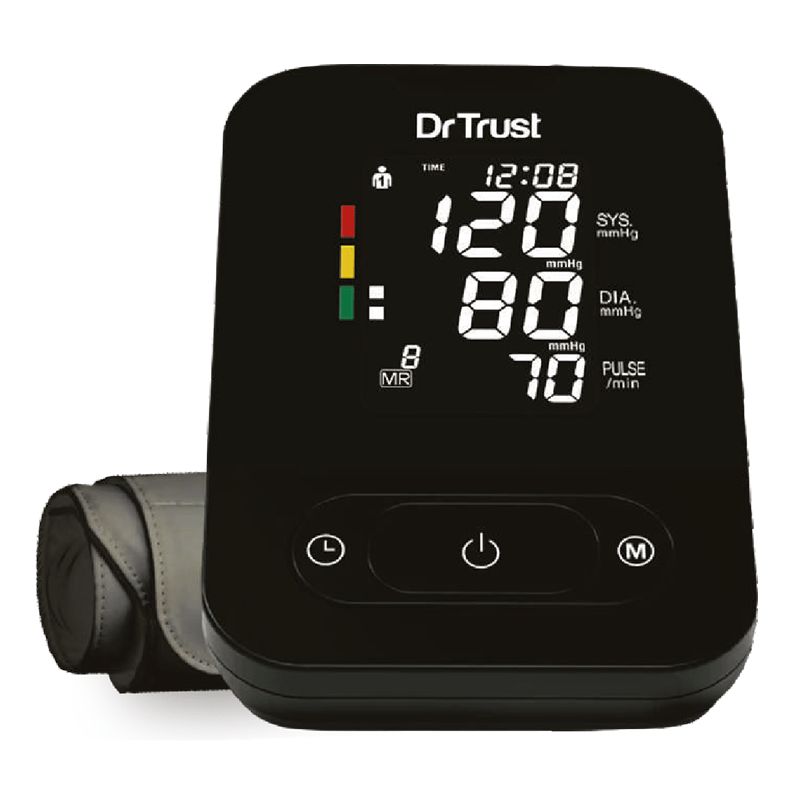A physically healthy body is evidence of low fat in the body. However, it is equally important to be cognizant of levels of body fat in your body to predict predisposition to any chronic disease. Low levels of extra body fat are considered overweight. Whereas high levels of extra body fat are considered obese. Before heading for any precautionary measure, an assessment of the body for its fat levels is essential.
Body Mass Index (BMI) is one such simple diagnostic tool for the assessment of body fat based on height and weight.
|
BMI Range |
Obesity Levels |
|
< 18.5 kg/m2 |
Under weight |
|
18.5-24.9 kg/m2 |
Normal weight |
|
25.0-29.9 kg/m2 |
Over weight |
|
≥30.0 kg/m2 |
Obese |
Evaluate your Obesity levels with Dr Trust Smart weighing scales on your smart phone with DrTrust360.
Comorbidities Associated with Body Mass Index (BMI)
BMI range demarcates your body type into underweight, normal weight, overweight, and obese. BMI of less than 18.5 kg/m2 is categorized as underweight. It can be the manifestation of the body, not absorbing nutrients in sufficient amounts or the body is not consuming the calories required in a day.
The underweight body is highly vulnerable to:
- Osteoporosis (bone loss)
- Anemia
- Immune disorders (getting sick frequently)
- Infertility issues
- Premature births
- Fatigue
So, if your BMI falls in this category, you should consult your physician for supplements or have a discussion over to increase your daily calorie intake.
If your BMI falls in the range of 18.5-24.9 kg/m2, then you are in a worry-free zone and it’s better to maintain this healthy range and indulge in a weight management diet only if you sense the risk of falling beyond this range.
If your BMI falls in the range of 25.0-29.9 kg/m2, then you better be attentive since you are overweight and at the high-end risk of emergence of:
- Cardiovascular disorders
- Hypertension
- Diabetes
- Liver disorders
- Arthritis
- Certain cancers at an early age
If your BMI falls in this category, it’s better to get going with physical activity of any sort, burn those extra calories, and indulge in a weight management diet to avoid the risk of an outbreak of health conditions.
A BMI of 30.0 kg/m2 or above is categorized as Obesity. It is further subcategorized into:
|
Class I |
BMI 30.0 - 34.99 kg/m2 |
|
Class II |
BMI 35.0- 39.99 kg/m2 |
|
Class III (Severe Obesity) |
BMI ≤ 40 kg/m2 |
Obesity is Consequence of:
- Excessive Calories intake due to unhealthy eating patterns
- Low levels of physical activities
- Certain medications
- Genetic history of the Family has a vital role in determining obesity.
Comorbidities associated with Obesity:
- Cardiovascular disorders
- Dyslipidemia ( increased levels of cholesterol and fats in the blood)
- Stroke
- Type 2 Diabetes/ Gestational Diabetes
- Hypertension
- Sleep apnea (serious sleep disorder associated with breathing difficulty)
- Liver Cirrhosis
- Osteoarthritis
- Gallstones
- Certain types of cancers (endometrial, breast, colon)
- Dental Health Problems (caries, periodontitis, and Xerostomia)
- Preeclampsia (high blood pressure during Pregnancy)
- Pre-pregnancy Obesity can cause perinatal death. Also, a recent analysis reports that there is an increased risk of daughters' Early pubertal growth due to Pre-pregnancy Obesity.1
- Psychosocially, Obesity has a long-term negative effect on mental health resulting in depression, anxiety, social isolation, discrimination, lower quality of life, and stigmatism.
Factors that may influence obesity level results
- Age: For the same BMI, older people tend to have more fat than younger.
- Gender: For the same BMI, women tend to have more fat than men.
- Muscle mass: BMI can over calculate body fat for professional athletes, and bodybuilders because they have increased muscle mass that weighs more than fat.
- Ethnicity: BMI also varies for people of different origins. For example, Asians have more body fat than other races.2
- Pregnancy and lactation: BMI is over calculated for pregnant women and lactating mothers
Remarks
Taking into account the above factors, BMI is not the only parameter to estimate body fat. It can be correlated with other body fat measuring parameters such as waist circumference, waist - to - hip ratio, Skinfold thickness, bioelectric impedance, Dual Energy X-ray Absorptiometry (DEXA), Hydro densitometry, Air displacement Plethysmography, MRI and CT scans to get accurate picture of body fat, particularly for those with BMI above 30 kg/m2.3














